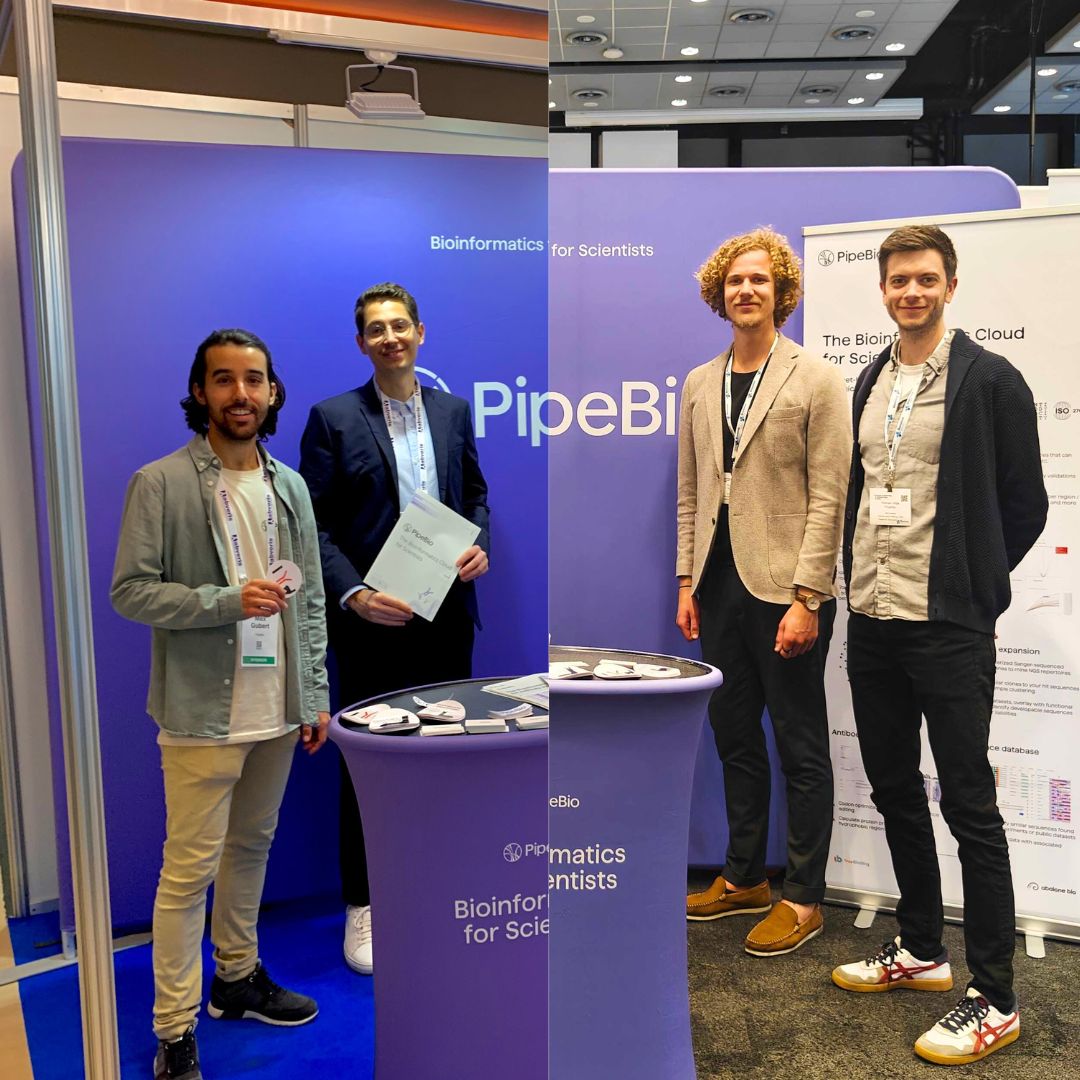The ambitious team behind PipeBio comes from different backgrounds, ranging from wet-lab biologists to computer engineers, with both academic and industrial experience. This diversity strengthens our team’s dynamics and empowers us to find better and faster solutions for our customers.
All of us share a strong passion for science, and that’s why in this blogpost we wanted to highlight some of our previous work that we are very proud of. Because in the end we can all agree on one thing: We are all scientists!
Our team members have published relevant studies in multiple fields and developed impactful tools to assist scientists around the world with their research. All together we have published more than 50 papers and accumulated above 13,000 citations.
We have also supported our customers’ work and PipeBio has been acknowledged in publications, such as in Huhtinen et al. (2023)1 where the PipeBio platform was used to analyze the enrichment of biophysically favorable antibody variants, and in Shapiro et al. (2023)2, where the authors applied optofluidics to discover single-domain antibodies from immunized alpacas and performed repertoire NGS analysis using PipeBio.
We come from different backgrounds

Bioinformatics, fungi and neural networks
Jannick has extensive experience in bioinformatics and in the drug development field, gained during his years in academia and later working in several bioinformatic companies and focusing on product development and delivering custom solutions to customers.
During his PhD in bioinformatics (he got tired of wet-lab work!), Jannick greatly contributed to the development of SignalP3, a well-known tool using neural networks and hidden Markov models for prediction of signal peptides. By introducing new features and optimizing the parameters of the neural network, he significantly improved the accuracy of SignalP but he also contributed to other prediction tools and papers focusing on various protein secretion pathways.
Jannick also contributed to an international study4 to sequence the genome of Aspergillus niger, a fungus commonly used for the industrial production of different substances such as citric acid. More precisely, he analyzed the secretion pathway of A.niger and the genes involved.
Lasers, software development and engineering
Owen is a mechanical engineer by training and has broad knowledge in the biotech world with expertise in software development, project management and product optimization.
Owen started off his professional engineering career investigating the dynamic load bearing characteristics of boring bars as used in high speed machining, in collaboration with Iscar Pacfiic. Shortly thereafter he joined a femtosecond laser micromachining research team, using lasers rather than milling cutters to machine precise and small features into a range of materials. In there, Owen helped develop a novel device for measuring PCR amplification in real time, and demonstrated femtosecond lasers use in a range of applications, such as in centrifugal microfluidics, diagnosis and orthopedic surgeries5, 6.
Owen has developed his entrepreneur skills by co-founding several companies and creating various applications, for example an iOS app for multilingual communication and a restaurant bookings SAAS.
Metalworks, RNA structure and NGS
Zsuzsanna has always been fascinated by computers, and wrote her first computer program at the age of 9. She also has a broad background in natural science, having obtained her bachelor’s degree in physics and biochemistry from the University of Cambridge.
After a brief detour in metallurgy, she finally specialized in bioinformatics and wrote her thesis in systems biology. During her PhD, Zsuzsanna focused on RNA secondary structure prediction models. She improved pfold, an algorithm that combines a stochastic context-free grammar model with an evolutionary model to predict RNA secondary structure7.
First, she developed PPfold, a multithreaded version of pfold which achieved lower computational times without compromising the accuracy of results. Later, Zsuzsanna incorporated experimental data into the PPfold algorithm and applied this method to generate a new secondary structure model for the HIV-1 genome. The results were consistent with previous studies, and the model also predicted novel conserved structures8, 9.
Zsuzsanna also has several years of industry experience designing and implementing algorithms for analyzing NGS data.

Hippocampus, Nordics and bioinformatics
Before jumping into the world of bioinformatics, Max used to juggle with brains, microscopes and electrodes in the lab. After an inspiring (and cold!) stay in Finland, where he got captivated by the complexity of the human brain while doing research on migraine pain and Alzheimer’s disease, Max continued his Nordic tour and moved to Sweden10, 11.
There, he studied Biomedicine at Karolinska Institutet and in his master thesis investigated learning and memory alterations in the hippocampus using a mouse model for cognitive dysfunction in schizophrenia12.
Seeking slightly warmer winters, Max moved on to the next Nordic country and continued his research career in Denmark where he decided to switch from the wet lab to the dry lab and pursue a master’s degree in Bioinformatics at Aarhus University. Before joining PipeBio, he worked with GWAS data to identify shared and differentiating genetics between autism spectrum disorder and major depressive disorder.
From numbers to biology and beyond
Following the typical atypical trajectory of life, Kris’ journey to bioinformatics, immunology and PipeBio has been an unpredictable one.
After finishing his Master’s degree in economics and business administration and mostly working with numbers of different kinds after graduation, Kris went on to jump across a few roles that included a few attempts at ideas for new startups in the digital platform and product space, only to feel the pull towards science, particularly, life sciences.
Moving from the basics of bioinformatics and molecular biology to more in-depth research, a change of field became timely and the would-be cradle that combined the software product aspect together with deep science in immunology and bioinformatics, PipeBio, was the perfect match for having an impact and helping enable world-class researchers advance the science and development of treatments for life-threatening illnesses.
Programming, proteins and prediction
From a young age, Erik had a keen fascination with biology and programming, and while growing up he started building small programs, addons and games to learn more about his interests. Later on, Erik decided to pursue a masters degree in Bioinformatics, where he became more interested in protein engineering, immunology and artificial intelligence.
In his master thesis, he presented NetSurfP-3.013, an improved version of an already existing tool for predicting secondary structure, solvent accessibility, structural disorder and backbone dihedral angles of proteins based on the amino acid sequence.
By adding a pre-trained protein language model to the algorithm, Erik and his colleagues managed to drastically decrease the running times compared to the previous version while keeping the prediction accuracy.
Erik enjoys the technical aspect of building tools that bring value to scientists and accelerate their research, and he has helped develop digital platforms for facilities at the university where he graduated from.
Single cells, Cerebro and coils (many coils) of DNA
Roman has always enjoyed creating software that helps scientists with their research. While doing his PhD in Computational Biology, Roman developed tools to visualize and analyze single cell data.
To help his colleagues with their single cell experiments, Roman developed Cerebro14, an interactive application to visualize transcriptomics data from single cells. Cerebro offers the user to view dimensional reductions such as t-SNE and UMAP, expression level of single genes or gene sets and trajectories.
Together with a colleague, Roman also created XenoCell15, a processing tool useful to separate cells by organism in single cell experiments, and proved its efficacy by separating human cells from mouse cells in xenograft single cell data (human cells transplanted into mice).
All that while working on his PhD, where Roman investigated the epigenetic landscape of aging mice16 to look for changes that might explain the functional decline associated with aging, with the aim to identify regions that regulate or potentially predict these changes.
Engineering chemicals, lipids and machines that learn
Nate has a wide range of industrial and academic experiences in the USA and UK. He has had an impact in fields such as fuel cell technology, microfluidics, machine learning model development applied to clinical medicine, biophysics and bioinformatics.
After a masters degree in chemical engineering from Columbia University and three years of industrial experience, Nate went on to win a Marie Curie Fellowship to pursue a PhD in biophysics at Imperial College London, where we developed both novel devices and modeling methodologies for measuring small molecule transport across lipid bilayer membranes17.
As a postdoctoral researcher, Nate built deep learning tools for applications such as predicting lipid phase behavior from small angle X-ray scattering experiments. Nate left academia in 2019 where he had an assortment of roles as a data scientist, machine learning researcher and engineer.
In these roles, Nate has developed a number of novel techniques, such as unsupervised methods for clustering cardiovascular patient outcome trajectories and supervised models for predicting early stage lung cancer18. Nate is excited to use his knowledge and experiences in the exciting field of antibody and protein engineering.
To conclude
We have diverse backgrounds and share several passions, but the prominent joining force is still advancing science. A good runner up ‘passion’ might be alpacawatching (cf. birdwatching). Who would not love them?









